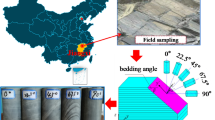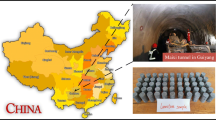Abstract
Although the study of TM (Thermo -Mechanics), HM (Hydraulic — Mechanics) and THM (Thermo — Hydraulic — Mechanics) coupling under a loading test have been under development, rock failure analysis under THM coupling and unloading is an emerging topic. Based on a high temperature triaxial unloading seep test for phyllite, this paper discusses the deformation and failure mechanism of phyllites under the “H↔M, T→H, T→M” incomplete coupling model with unloading conditions. The results indicate that the elastic modulus and initial permeability decrease and the Poisson’s ratio increases with increasing temperature; the elastic modulus decreases and the Poisson’s ratio and initial permeability increase with increasing water pressure. During the unloading process, rock penetrability is small at the initial elastic deformation phase, but the penetrability increases near the end of the elastic deformation phase; mechanisms involving temperature and water pressure affect penetrability differently. Phyllite failure occurs from the initial thermal damage of the rock materials, splitting and softening (which is caused by pore water pressure), and the pressure difference which is formed from the loading axial pressure and unloading confining pressure. The phyllite failure mechanism is a transtensional (tension — shearing) failure.
Similar content being viewed by others
References
Ai WM (2005) Experimental Study and Numerical Analysis of the Coupling between Seepage Field and Stress Field of Rock Mass with Unloading. PhD Thesis, Chongqing University, Chongqing, China. (In Chinese)
Borgesson L, Fujita T, Nguyen TS, et al. (2001) Thermo hydro mechanical characterization of a bentonite based buffer material by laboratory tests and numerical back analysis. International Journal of Rock Mechanics and Mining Sciences 38(1): 95–104.
Chen Z, Narayan SP, Yang Z, et al. (2000) An experimental investigation of hydraulic behaviour of fractures and joints in granitic rock. International Journal of Rock Mechanics & Mining Sciences 37(7): 1061–1071.
Gao CY, Xu J, He P, et al. (2005) Study on mechanical properties of marble under loading and unloading conditions. Chinese Journal of Rock Mechanics and Engineering (3): 456–460. (In Chinese)
Garzón E, García-Rodríguez IG, Ruiz-Conde A, et al. (2009) Phyllites used as waterproofing layermaterials for greenhouses crops in Spain:multivariate statistical analysis applied to their classification based on X-ray fluorescence analysis. X-Ray Spectrometry 38: 429–438.
Garzón E, Sánchez-Soto PJ, Romero E (2010) Physical and geotechnical properties of clay phyllites. Applied Clay Science 48: 307–318.
Guvanasen V, Chan T (2000) A three-dimensional numerical model for thermo-hydromechanical deformation with hysteresis in a fractured rock mass. International Journal of Rock Mechanics and Mining Sciences 37(l/2): 89–106.
Hart RD, John CMST (1986) Formulation of a fully-coupled thermal-mechanical-fluid model for non-linear geologic systems. International Journal of Rock Mechanics and Mining Science & Geomechanics Abstracts 23(3): 213–224.
He YL (2003) Study on Relevant Experiments and Quantification of Coupling Strength for Coupled Thermohydro-mechanical Behaviour of Saturated Rocks. PhD thesis, Southwest Jiaotong University, Chengdu, China. (In Chinese)
Hsiung SM, Chowdhury AH, Nataraja MS (2005) Numerical simulation of thermal mechanical process observed at the Drift Scale heater test at Yucca Mountain, Nevada, USA. International Journal of Rock Mechanics and Mining Sciences 42(6): 652–666.
Huang RQ, Huang D (2008) Experimental research on mechanical properties of granites under unloading condition. Chinese Journal of Rock Mechanics and Engineering 27(11): 2205–2223. (In Chinese)
Huang XH (2007) Research on the Rheological Process of Fractured Granite under Thermo-hydro-mechanical Conditions in Excavation Disturbed Zone and Its Cellular Automata Simulation. PhD thesis, Institute of Rock and Soil Mechanics, Chinese Academy of Sciences, Wuhan, China. (In Chinese)
Jing L, Tsang CF, Stephanson O (1995) Decovalex — an international cooperative research project on mathematieal models of coupled THM processes for safety analysis of radioactive waste repositories. International Journal of Rock Mechanics and Mining Science & Geomechanics Abstracts 32(5): 389–398.
Li TB, Wang LS (1993) An experimental study on the deformation and failure features of a basalt under unloading condition. Chinese Journal of Rock Mechanics and Engineering 12(4): 321–327. (In Chinese)
Li XQ, Li WP, Li HL, et al. (2005) Experimental study on permeability of sandstone during post-peak unloading of the confining pressure. Journal of Engineering Geology 13(04): 481–484. (In Chinese)
Liang NH, Liu XR, Bao Tai, et al. (2005) Experimental study on the characteristic of seepage with unloading rock mass. Journal of Chongqing University(Natural Science Edition) 28(10): 133–135. (In Chinese)
Liu Y, Cai YQ, Liu QS, et al. (2001) Thermal-hydraulicmechanical coupling constitutive relation of rock mass fracture interconnectivity. Chinese Journal of Geotechnical Engineering 02:196–200. (In Chinese)
Millard A, Durin M, Stietel A, et al. (1995) Discrete and continuum approaches to simulate the thermo-hydromechanical couplings in a large, fractured rock mass. International Journal of Rock Mechanics and Mining Science & Geomechanics Abstracts 32(5):409–434.
Myer LR (1991) Hydromechanical and seismic properties of fractures. Proceedings of the 7th ISRM International Congress on Rock Mechanics. Aachen, Germany, 16–20 September, 1991, pp. 397–404.
Qiu SL, Feng XT, Zhang CQ (2010) Experimental research on mechanical properties of deep-buried marble under different unloading rates of confining pressures. Chinese Journal of Rock Mechanics and Engineering 29(9): 1807–1817. (In Chinese)
Wang JN, Peng SP, Meng ZP (2001) Permeability rule in full strain-stress process of rock under triaxial compression. Journal of University of Science and Technology Beijing 23(6): 489–491. (In Chinese)
Xu DM (2008). Permeability and Mechanics Characteristics Test Studying on Rock or Rock Mass under High Seepage Pressure. PhD thesis, Chengdu University of Technology, Chengdu, China. (In Chinese)
Yang LZ, Huang T (2000) Preliminary study on flow — stress-temperature coupling effect of fractured rock in the geological environment. Hydrogeology and Engineering Geology 27(2):33–35. (In Chinese)
Zhang CL (2007) Multi-fields Coupling Analysis on Deep Rock Mass and Unloading Study on Underground Excavation. PhD thesis, Wuhan University of Technology, Wuhan, China. (In Chinese)
Zhao XD, Zhou GQ, Li SS (2009) Research on deviatoric stress variation laws for deep frozen clay at different temperature gradients. Chinese Journal of Rock Mechanics and Engineering (08): 1646–1651. (In Chinese)
Zhao XD, Zhou GQ, Li SS (2010) Deformation properties of frozen sand during loading and unloading in the presence of a thermal gradient. Journal of China University of Mining & Technology 30(2): 158–162. (In Chinese)
Zheng D, Ju NP (2011) Scanning electronic microscope tests for rock micro-rupture mechanism and fracture characteristic of phyllite. Journal of Engineering Geology 19(3):317–322. (In Chinese)
Zhou QC (2006) Study on the Mechanical Property of a Sandstone under Geothermal-mechanical and Hydraulicmechanical Coupling. PhD thesis, Institute of Rock and Soil Mechanics, Chinese Academy of Sciences, Wuhan, China. (In Chinese)
Zhu JB (2009) Study on Unloading Mechanics and its Reological Properties of Rock under High Stress. PhD thesis, Institute of Rock and Soil Mechanics, Chinese Academy of Sciences, Wuhan, China. (In Chinese)
Author information
Authors and Affiliations
Corresponding author
Rights and permissions
About this article
Cite this article
Meng, L., Li, T., Xu, J. et al. Deformation and failure mechanism of phyllite under the effects of THM coupling and unloading. J. Mt. Sci. 9, 788–797 (2012). https://doi.org/10.1007/s11629-012-2286-9
Received:
Accepted:
Published:
Issue Date:
DOI: https://doi.org/10.1007/s11629-012-2286-9




